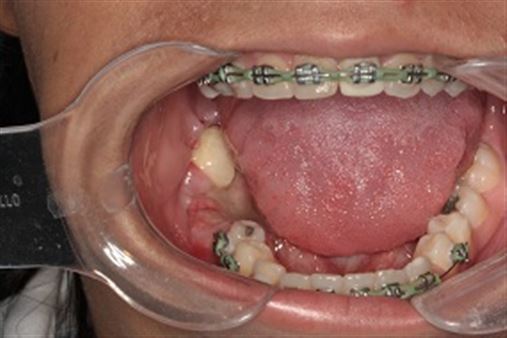Vol. 9 – Número 33 – 2017 CADERNO DE IMPLANTODONTIA Relato de caso/Case report Página 39-43 Ressecção segmentar de mandíbula para exérese de ameloblastoma unicístico por acesso intrabucal – relato de caso Segmental mandibular resection for removal of unicystic ameloblastoma by intraoral access – case report Julio Cesar de Paulo Cravinhos1 Iluska Castro dos Santos2 Sérgio Antônio Pereira Freitas3 Ingrid Madeira de Barros Nunes4 Darklilson Pereira Santos5 Resumo O ameloblastoma é um tumor benigno, com origem no epitélio odontogênico. Ele tem crescimento lento e é localmente invasivo. Ocorre na idade média de 36 anos, geralmente localizado na região molar e ramo da mandíbula, sem predileção entre os sexos, radiograficamente pode ser uni ou multilocular e pode ou não estar associado a um dente não irrompido. A paciente em questão apresentou-se com aumento de volume no lado direito da mandíbula. O exame radiográfico revelou uma lesão radiolúcida unilocular, o resultado histopatológico foi de ameloblastoma unicístico e como modalidade de tratamento realizou-se a ressecção cirúrgica da região afetada. O ameloblastoma tem três variantes: sólido/multicístico, unicístico e periférico. O ameloblastoma unicístico refere-se às lesões que mostram características clínicas e radiográficas de um cisto dos maxilares, mas no exame histológico mostra-se uma característica típica de ameloblastoma. As opções de tratamento variam desde uma terapia cirúrgica conservadora até uma cirurgia radical. Devido sua alta taxa de recorrência, a cirurgia radical ainda é a principal modalidade de tratamento. O diagnóstico pré-operatório do ameloblastoma unicístico pode ser difícil, por isso o acompanhamento é obrigatório devido às possíveis recorrências. Este trabalho tem como objetivo relatar um caso de remoção cirúrgica de ameloblastoma unicístico tratado por meio da ressecção segmentar da região afetada. Descritores: Ameloblastoma, mandíbula, neoplasias mandibulares. Abstract The ameloblastoma is a benign tumor, originating from the odontogenic epithelium. It has slow growth and is locally invasive. It occurs at an average age of 36, usually located in the molar region and the mandible branch, without preference between the sexes, radiographically can be uni or multilocular and may or may not be associated with an unerupted tooth. Patient presented with swelling on the right side of the jaw. The radiographic examination revealed a radiolucent unilocular lesion, histopathology was unicystic ameloblastoma and as a treatment modality was performed surgical resection of the affected region. The ameloblastoma has three variants: solid/multicystic, unicystic, and peripheral. The unicystic ameloblastoma refers to lesions that show clinical and radiographic features of a cyst jaws, but the histological examination showed a typical characteristic of ameloblastoma. Treatment options range from a conservative surgical therapy to radical surgery. Because of its high rate of recurrence, radical surgery is still the primary treatment modality. The preoperative diagnosis of unicystic ameloblastoma can be difficult, so monitoring is required due to possible recurrences. This study aims to report a case of surgical removal of unicystic ameloblastoma treated by segmental resection of the affected region. Descriptors: Ameloblastoma, mandible, mandibular neoplasms. 1 Me., Prof. Assistente Nível I – Área de CTBMF e Implantodontia – UFPI. 2 CD – UFPI. 3 Prof. da Área de Radiologia – IFPI, Prof. Adjunto Dr. 4 Profª. Adjunta da Área de Anatomia Humana – FACIME/UESPI. 5 Prof. da Área de CTBMF – UESPI, Prof. Adjunto
Este conteúdo é restrito a membros do site. Se você é um usuário registrado, por favor faça o login. Novos usuários podem registrar-se abaixo.




